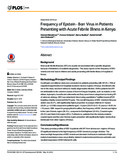| dc.contributor.author | Masakhwe, C | |
| dc.contributor.author | Ochanda, H | |
| dc.contributor.author | Nyakoe, N | |
| dc.contributor.author | Ochiel, D | |
| dc.contributor.author | Waitumbi, J | |
| dc.date.accessioned | 2017-05-15T09:36:14Z | |
| dc.date.available | 2017-05-15T09:36:14Z | |
| dc.date.issued | 2016 | |
| dc.identifier.citation | PLoS One. 2016 May 10;11(5):e0155308. doi: 10.1371/journal.pone.0155308. eCollection 2016. | en_US |
| dc.identifier.uri | http://journals.plos.org/plosone/article?id=10.1371/journal.pone.0155308 | |
| dc.identifier.uri | http://hdl.handle.net/11295/100912 | |
| dc.description.abstract | BACKGROUND:
Most acute febrile illnesses (AFI) are usually not associated with a specific diagnosis because of limitations of available diagnostics. This study reports on the frequency of EBV viremia and viral load in children and adults presenting with febrile illness in hospitals in Kenya.
METHODOLOGY/PRINCIPAL FINDINGS:
A pathogen surveillance study was conducted on patients presenting with AFI (N = 796) at outpatient departments in 8 hospitals located in diverse regions of Kenya. Enrollment criterion to the study was fever without a readily diagnosable infection. All the patients had AFI not attributable to the common causes of fever in Kenyan hospitals, such as malaria or rickettsiae, leptospira, brucella and salmonella and they were hence categorized as having AFI of unknown etiology. EBV was detected in blood using quantitative TaqMan-based qPCR targeting a highly conserved BALF5 gene. The overall frequency of EBV viremia in this population was 29.2%, with significantly higher proportion in younger children of <5years (33.8%, p = 0.039) compared to patients aged ≥5 years (26.3% for 5-15 years or 18.8% for >15 years). With respect to geographical localities, the frequency of EBV viremia was higher in the Lake Victoria region (36.4%), compared to Kisii highland (24.6%), Coastal region (22.2%) and Semi-Arid region (25%). Furthermore, patients from the malaria endemic coastal region and the Lake Victoria region presented with significantly higher viremia than individuals from other regions of Kenya.
CONCLUSIONS/SIGNIFICANCE:
This study provides profiles of EBV in patients with AFI from diverse eco-regions of Kenya. Of significant interest is the high frequency of EBV viremia in younger children. The observed high frequencies of EBV viremia and elevated viral loads in residents of high malaria transmission areas are probably related to malaria induced immune activation and resultant expansion of EBV infected B-cells. | en_US |
| dc.language.iso | en | en_US |
| dc.publisher | University of Nairobi | en_US |
| dc.rights | Attribution-NonCommercial-NoDerivs 3.0 United States | * |
| dc.rights.uri | http://creativecommons.org/licenses/by-nc-nd/3.0/us/ | * |
| dc.title | Frequency of Epstein - Barr virus in patients presenting with acute febrile illness in Kenya. | en_US |
| dc.type | Article | en_US |



